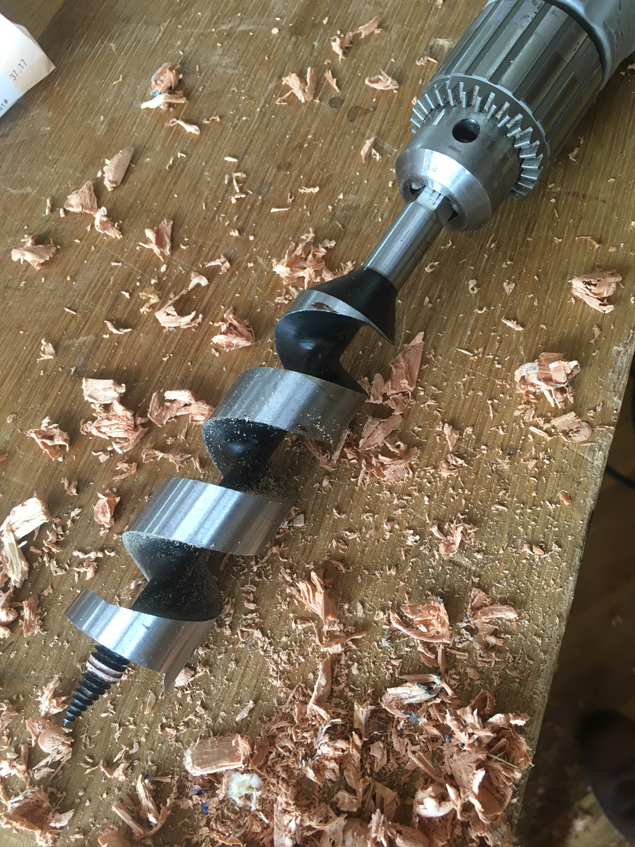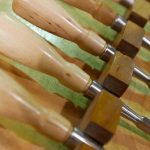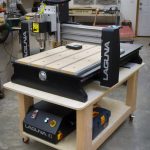We may receive a commission when you use our affiliate links. However, this does not impact our recommendations.
Making large-diameter mortises for chairs or staked tables requires big drill bits and a way to drive them. Usually a drill press won’t work because the workpiece is too large and the angles are too odd. So here are some bits that work – and some to avoid.
To drive big bits (1-1/4” and bigger), you probably need a corded drill. I’ve tried using a brace, but that’s a tall order in hard woods. Battery drills, for the most part, aren’t up to the task either. I prefer a corded drill with a traditional keyed 1/2” chuck.
The type of bit is also important. My favorite kind is what gets labeled a “ship’s auger,” shown in the photo above. This has a lead screw that is long enough that you can tilt the bit for compound angles (the lead on a normal Forstner is too short for anything but shallow angles). The solid body of the auger keeps your bit on track with little chance for wandering. The downside is these bits are your most expensive option – an 1-1/4” ship’s auger is about $25 at my hardware store. Another brand I’ve had great luck with is WoodOwl.
A similar option is the shorter auger shown above. It’s about half the price of the ship’s auger. Its downsides are that its spurs along the rim are fairly short and ineffective. So the entry hole is gonna get a little torn up. Also, it’s short. So it will wander in holes deeper than 2”.
The third type of bit that I like is a spade bit with a lead screw. The lead screw makes the bit fairly aggressive and reduces its tendency to wander. These bits are usually about $6 and work surprisingly well.
What doesn’t work well for accurate mortises is the traditional spade bit with a traditional tip (i.e. no lead screw). This bit jumps around and rattles too much for accurate work. It is the cheapest of the bunch, but also the least useful.
Or maybe this bit is the least useful. Sometimes called a “cup” bit, I decided to give it a go. The long drill bit in the center allows you to tilt the bit to almost any chairmaking angle. But the outer cutting rim is a joke. It clogs immediately because there’s no place for shavings to go. So you have to pull the bit out every 1/8” and clean out its gullets.
Note that these recommendations are for large-diameter bits. For smaller-diameter holes, an auger and a brace are my preference.
— Christopher Schwarz
Here are some supplies and tools we find essential in our everyday work around the shop. We may receive a commission from sales referred by our links; however, we have carefully selected these products for their usefulness and quality.














“Battery drills, for the most part, aren’t up to the task either.”
You should try the newer brushless-motor cordless drills, especially the right-angle “hole hawg” types.
Another option I’ve read about (but not used) is Festool ZOBO Forstner-style Drill Bits which have swappable centers: a shorter point, a longer point to assist in starting angled holes, and a twist-drill bit center.
https://www.popularwoodworking.com/techniques/new-festool-zobo-forstner-style-drill-bits
https://www.fine-tools.com/zobo-S2-C.html https://www.fine-tools.com/zobo-S2-systemzubehoer.html
Also saw this: Colt MaxiCut® Plus Forstner Bit with Lip & Spur Drill Center Point https://www.fine-tools.com/maxicutplus.html
And this: FAMAG Bormax Centre Drill Forstner Bits https://www.fine-tools.com/staketen-bormax.html
Available in many sizes in many (specialty) places but probably not the BORG.
Traditional Woodworker, the only source I know of for Wood Owl auger bits, has their website closed and their phone number/voice mail is full and not taking any more messages. Any idea if they are having problems and/or are no longer open?
“To drive big bits (1-1/4” and bigger), you probably need a corded drill. I’ve tried using a brace, but that’s a tall order in hard woods.”
Hi Chris
I have not used as large a bit as this, however I have drilled many 3/4″ holes with a brace. The other day I needed to do so into a particularly hard section of Jarrah, and the bit was not biting the hard wood. the screw was fine, but the wood was just too hard.
I recalled a tip about drilling Forstner bits with a brace – add a pilot hole. I decided to try this with the RJ auger bit, drilling a hole about as wide as the lower third of the leading screw. What a difference! The screw bit into the side walls of the pilot hole and pulled itself into the cut with ease.
Perhaps a pilot hole might do away with the need for fine- and coarse lead screws?
Regards from Perth
Derek
Chris, what diameter do you recommend for Roman workbench legs? As wide as we can get ’em?
Been wanting this info forever. Thanks Chris. I have also never had luck using the hole saw on pretty much any application unless my goal was to create a scalding hot cup to burn my work with.